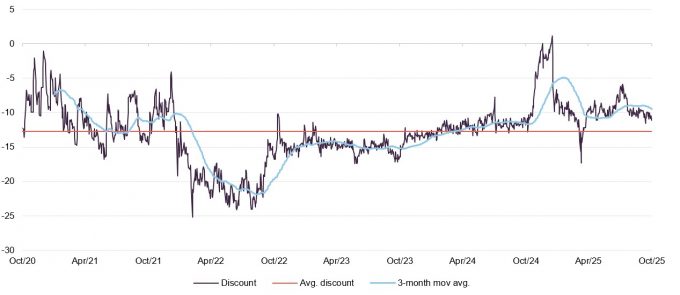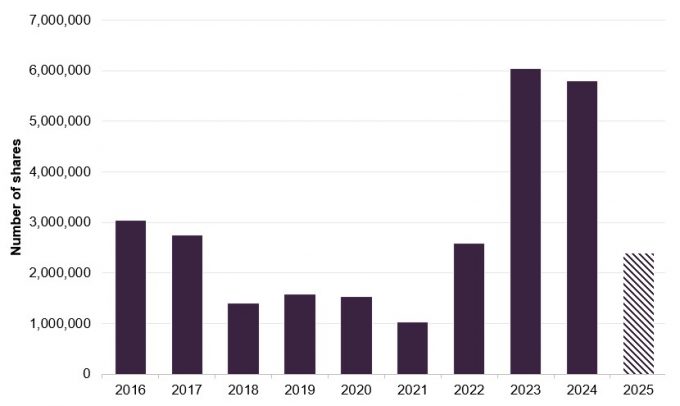Focused on the future
In January, the reasons were set out as to why Saba Capital’s proposals were considered by the management not to be in Herald Investment Trust (HRI) shareholders’ interest, and why management recommended that shareholders vote against them. The majority of HRI’s investors voted against Saba’s proposals.
Whilst the continued presence of Saba on the shareholder register may create some uncertainty, HRI’s performance has remained strong, with the portfolio benefitting from its exposure to Artificial Intelligence (AI). The managers believe there may be further potential as the theme broadens and extends to smaller businesses.
HRI has continued to increase its international exposure relative to the UK, with North America now representing the largest geographical weighting. According to the managers, this reflects a more challenging home market and a greater number of opportunities internationally.
Small-cap technology, telecommunications and multi-media
HRI’s objective is to achieve capital appreciation through investments in smaller quoted companies in the areas of telecommunications, multimedia and technology. Investments may be made across the world, although the portfolio has traditionally had a strong position in UK stocks.
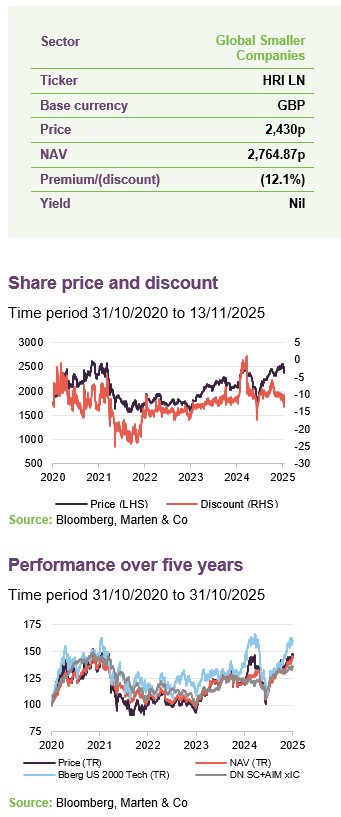
| 12 months ended | Share price total return (%) | NAV total return (%) | Deutsche Numis ex IC plus AIM (%) | B’berg US 2000 Tech TR (%) |
|---|---|---|---|---|
| 31/10/21 | 36.0 | 39.0 | 43.5 | 50.0 |
| 31/10/22 | (26.6) | (24.3) | (24.9) | (19.5) |
| 31/10/23 | (6.4) | (6.8) | (5.9) | (9.0) |
| 31/10/24 | 28.9 | 21.7 | 20.0 | 23.1 |
| 31/10/25 | 20.4 | 21.0 | 11.0 | 19.5 |
Saba threat defeated; HRI looking to the future
In the last note, published in January, it was detailed that Saba Capital, a US-based hedge fund, had built up a substantial stake in HRI, and had requisitioned its board with proposals to remove all members of the board and dismiss the current investment manager, replacing them with Saba appointees in each case. The reasons for the view that Saba’s proposals were not in shareholders’ best interests and the recommendation that shareholders should vote against the resolutions to protect their investment in the trust were set out.
Saba’s proposals were resoundingly defeated by HRI’s shareholders
The requisitioned general meeting held on 22 January 2025 resulted in HRI’s shareholders voting against the proposals by 65.1% to 34.9% on a turnout of 80.6%. Excluding the Saba votes, 0.15% of non-Saba shareholders voted in favour of its proposals. At the AGM in March, 99.9% of non-Saba votes cast were in favour of the continuation of the trust. In the investment trust sector, shareholders of the six other trusts targeted in the same way also rejected Saba’s resolutions.
Whilst the initial threat from Saba appears to have passed, the hedge fund retains a large position. As at 3 November, it held 25.1% of the share capital and a further 5.6% of voting rights through other financial instruments. Although its overall voting rights are therefore over 30%, it is not obliged to make an offer for the company, as such a large holder would be ordinarily, as it breached the threshold passively, through HRI buying back its own shares.
Until recently, Saba has not given any indication of its future plans for its stake and is not in active communication with HRI’s board or manager. However, it has recently been reported that Saba plans to launch an exchange-traded fund (ETF) that will target investment companies and trusts on wide share price discounts. It is possible that Saba’s HRI stake could be transferred to this new vehicle at some point.
Katie Potts and the rest of the management team have continued to focus on managing HRI’s portfolio, which the manager states is unique within the UK investment universe.
Market update
Trump’s Liberation Day tariff announcements led to market upheaval
Our last note was published five days before the inauguration of Donald Trump for his second term as US president. The months since have been dominated by his actions. The fall-out from his “Liberation Day” tariff announcements in April appears to have been significant, when Trump announced a baseline 10% tariff for all countries, and additional reciprocal levies, the levels of which were calculated based on bilateral deficits with the US.
Developments since April have been varied. A week after the initial announcement, significant fluctuations in equity, currency and bond markets appeared to prompt a 90-day pause from the White House on the additional tariffs above the base line 10% level.
Since then, the administration has focused on securing bilateral trade agreements. In May, the UK reached a deal with a baseline 10% rate, while the EU reached a framework deal in July with most EU goods facing 15% tariffs. In August, Trump announced a further 90-day pause on sweeping tariffs on China until 10 November as talks continue.
What happens from this point appears to be unclear to most observers, including the US president. Markets have returned to a positive mood. The S&P 500 has more than erased its losses since April, trading at an all-time high. Similarly, the FTSE 100 is up year-to-date and is at or near its record high.
More relevant to HRI is the performance of smaller company indices. Figure 1 shows two of these: Bloomberg US 2000 Technology (small- and mid-cap US technology) and Deutsche Numis Smaller Companies Plus AIM Ex Inv Cos (bottom 10% of the UK market).
Figure 1: Markets year-to-date to 3 November 2025, indices rebased to 100
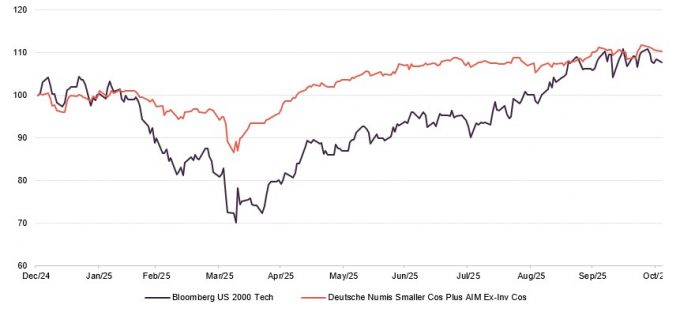
Source: Bloomberg, Marten & Co
Both have followed a similar course this year, which appears to be similar to the large-cap indices. All declined in the early part of the year, particularly following “Liberation Day”, and have steadily recovered since. The decline in technology stocks was notable, given the sector’s exposure to supply chain disruption and sensitivity to changes in market sentiment, particularly among stocks with a greater focus on growth. As market sentiment has improved since April, the recovery in the Bloomberg US 2000 Technology index has also been notable.
A mixed inflation and interest rate picture
Away from tariffs, investors have continued to focus on the future direction of inflation and interest rates.
Figure 2: Inflation over three years to 30 September 2025
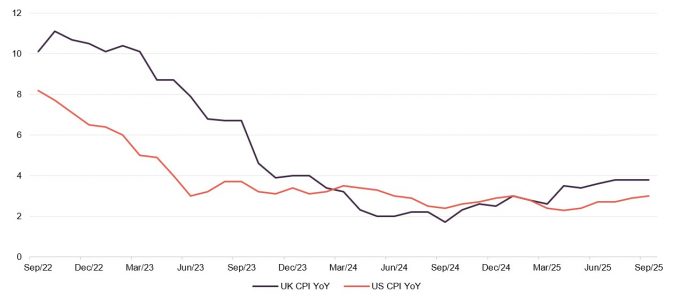
Source: Bloomberg, Marten & Co
As shown in Figure 2, inflation has fallen in both the US and UK in recent years, as it has across the developed world, and this has enabled central banks to reduce interest rates. However, price rises have remained higher than in the pre-2022 period, and are above the 2% target in both the US and UK. In the UK, CPI has increased in recent months, reaching nearly 4%. The Bank of England has maintained its base rate at 4% at its November meeting. The Federal Reserve reduced its main rate by 0.25% at its most recent meeting. This was the second cut of 2025, and the recent pace of cuts has not met the expectations of some investors and President Trump.
Sticky inflation therefore remains a potential risk to elevated stock markets. This may be particularly relevant for smaller companies and the technology sector, both of which impact HRI. In each case, shares are valued largely on future earnings and growth expectations, which are discounted by the current interest rate. Therefore, elevated rates could limit further gains, particularly if future cuts take longer to materialise than investors anticipate, or if higher rates are instead required to address a sustained inflationary environment.
Technology sector – large cap stocks driven by momentum, and AI
Investor sentiment towards the technology sector appears to remain positive, which may be influenced by the ongoing artificial intelligence (AI) trend. AI appears to be contributing to momentum in the sector, which was briefly interrupted by uncertainty related to “Liberation Day” tariffs; however, this impact has primarily affected larger companies. There appears to be continued demand for cloud, semiconductor, and software products.
HRI – capitalising on themes within technology
HRI has invested over many years in specific themes within the technology sector; in the past this has included areas such as “software as a service” (SaaS). The current portfolio, and recent trading activity, show exposure to a number of themes that are present in the market at this time.
AI – not just a mega-cap story
The AI theme is benefitting smaller companies, which are often on lower valuations
Across the technology sector, AI appears to be the most significant theme at present. The majority of capital continues to flow into the largest American businesses, including Alphabet, Meta, Microsoft, Tesla, NVIDIA, Apple, and Amazon. There also appears to be spill over into smaller companies. In some cases, this may reflect investor sentiment, while in others it could be related to a company’s specific role in AI development. Large-cap valuations in many cases remain elevated, and there may be opportunities among smaller companies.
Within HRI, AI appears to have been a significant factor behind a concentration of returns in recent years. Over the period from 1 January 2020 to 30 June 2025, HRI made total gains of £497m, with 45% of this coming from four stocks: Super Micro Computer, BE Semiconductor Industries, Fabrinet and Celestica. All four are involved in AI infrastructure.
This concentration of returns has been exemplified by the performance of Celestica, HRI’s largest holding.
Celestica Inc
Figure 3: Celestica Inc (USD)
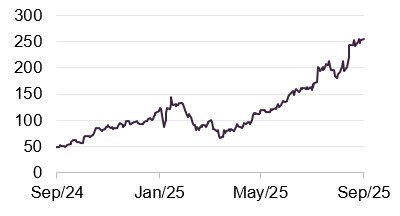
Source: Bloomberg
Celestica (www.celestica.com) is a Canadian-American technology manufacturer specialising in hardware platforms and supply-chain services. The company was examined in detail in the previous note. Its share price has increased over the past year, as shown in Figure 3.
Celestica appears to have benefited from AI infrastructure trends, and investors seem to view the company as having shifted from an electronics and machinery company to a participant in the AI and hyperscaler supply chain.
A key factor in the rally appears to be Celestica’s increased involvement in AI networking and cloud infrastructure through its Connectivity & Cloud Solutions (CCS) business, as well as computer hardware. The company reports partnerships with hyperscalers and design-manufacturing capabilities for server infrastructure. In its recent quarterly update, Celestica reported 21% year-on-year revenue growth and raised guidance, with much of the increase attributed to demand within its CCS business.
Investing across the phases of AI adoption
Since the emergence of AI as an investable theme, most of the focus appears to have been on infrastructure and the supply chain, in particular large language models (LLMs), graphics processing units (GPUs), accelerators and networking. HRI’s portfolio has exposure to this theme through holdings such as Celestica, Fabrinet and Super Micro Computer.
HRI’s managers believe that the AI theme is moving beyond the infrastructure layer to a data and application layer, and that the beneficiaries and adaptors may be starting to broaden out. According to HRI’s managers, a new wave of customer-facing, revenue-generating products appears to be emerging. They state that implementation costs are falling, and that most value may be accruing to companies that hold data. HRI’s portfolio includes several companies that managers identify as being involved in this next iteration of AI, including Five9 and Sidetrade.
Five9
Figure 4: Five9 (USD)
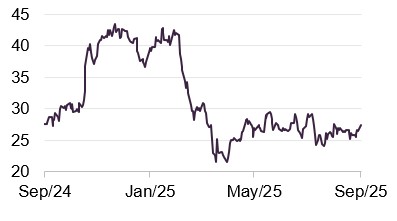
Source: Bloomberg
Five9 (www.five9.com) is a US provider of cloud-based “contact-centre-as-a-service” software. Its platform allows companies to manage customer interactions across voice, chat, email, SMS, and social channels, while embedding analytics and AI to support efficiency and service quality. Five9 appears to benefit from the ongoing shift away from legacy on-site systems towards AI-powered systems in the cloud.
Five9’s shares have declined in recent years. At the end of 2024, they experienced a rapid re-rating, which may have been influenced by interest in its platform, double-digit revenue growth, and activist pressure for margin expansion and strategic action. This was followed by a correction beginning in February. In addition to a deterioration in sentiment towards the wider sector, there were concerns about profitability and free-cash-flow sustainability after Five9 repaid large convertible notes, reducing its cash buffer. A second-quarter 2025 earnings miss, management changes, and ongoing activist scrutiny contributed to uncertainty.
For the last full year, the company reported revenue of just over $1bn, an increase of approximately 14% from the prior year, and management has indicated expectations of further growth in 2025, citing continued uptake of AI-driven features. For HRI, Five9 provides exposure to a company that management describes as a global leader in cloud communications and next-generation customer-experience technology with a recurring-revenue model.
Sidetrade
Figure 5: Sidetrade (EUR)
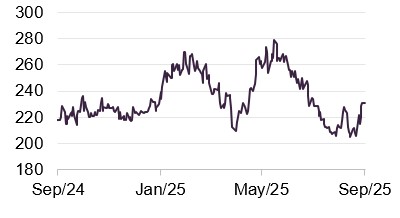
Source: Bloomberg
Sidetrade (www.sidetrade.com) is a French software company specialising in AI-powered “order-to-cash” solutions that are designed to help its customers optimise their cash collection and working capital. Its cloud platform uses predictive analytics and machine learning to forecast customer payment behaviour, automate processes and improve cash-flow visibility.
The company serves a client base spanning manufacturing, technology, media, and professional services, and may benefit from the long-term trend for digital transformation of cash management.
Sidetrade has reported double-digit revenue growth, which appears to be associated with expanding subscription income and international sales, particularly in North America and the UK, which generate the majority of new business. The company’s margins and recurring revenues appear to support a robust balance sheet and cash generation. Sidetrade provides exposure to a company in the AI-driven financial software sector with high customer retention and a subscription-based business model.
Exposure to companies benefiting from increased defence spending
There are a number of non-AI growth drivers within the technology sector. For HRI, these include robotics and machine vision through companies such as Ouster and Advantech, and space technology through Spire Global, Filtronic, and Lumibird.
Defence may be relevant given current geopolitical instability, including developments in the US presidency, European rearmament, and ongoing conflicts in the Middle East, eastern Europe and other regions. The war in Ukraine has highlighted the use of drones and autonomous systems in conflict, and, together with laser technology, these areas may present opportunities for smaller defence suppliers. Two companies in this area that have recorded strong performance over the past year are Cohort in the UK and Leonardo DRS in the US.
Cohort
Figure 6: Cohort (GBP)
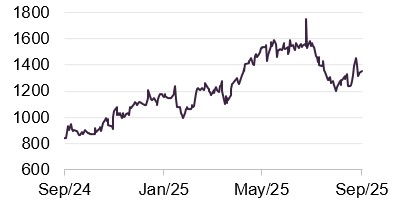
Source: Bloomberg
Cohort (www.cohortplc.com) is a UK-based defence technology group that provides specialist products and services across electronic warfare, surveillance, communications, and training systems. Operating through six subsidiaries, the group supplies solutions to the UK Ministry of Defence and a range of international customers. Its activities include counter-drone technology, autonomous maritime systems, and secure communications. The company appears to be experiencing increased demand for defence capabilities and networked warfare.
The company has reported growth in recent years, supported by an order book and increased overseas revenues. Contract wins in naval electronic warfare and surveillance, together with long-term service agreements, may contribute to revenue visibility. In addition, Cohort’s diversified portfolio and focus on high – value, niche segments of the defence market may allow the company to compete against larger companies while maintaining margins.
HRI’s managers believe Cohort should be well positioned to benefit as UK and allied governments reprioritise defence modernisation and resilience. According to HRI’s managers, this trend may continue, with NATO countries recently committing to eventually spend 3.5% of their GDP on defence, which is above the current level in most cases.
Leonardo DRS
Figure 7: Leonardo DRS (USD)
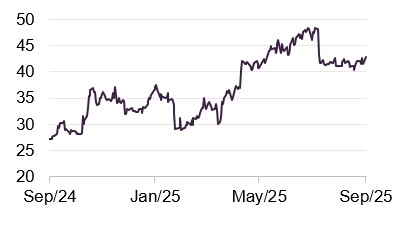
Source: Bloomberg
Leonardo DRS (www.leonardodrs.com) is a US defence technology company specialising in advanced sensors, network computing, force-protection systems and integrated mission solutions for the US military and allied forces. This appears to position the company within sectors such as autonomous operations and next-generation communications.
The company operates as a majority-owned subsidiary of Leonardo S.p.A., the Italian aerospace and defence group. Leonardo S.p.A. retains around 73% of the US business and provides strategic oversight and technological collaboration, while DRS remains listed independently on NASDAQ. This structure enables Leonardo DRS to access US defence contracts and maintain security clearances as an American entity, while also drawing on its parent’s global R&D capabilities and international customer base.
Leonardo DRS has recently reported steady growth, supported by an order backlog and exposure to US defence priorities such as electronic warfare and power systems for naval platforms. Recent awards for next-generation sensor and computing programmes suggest the company has a presence in supplying mission-critical technologies.
Asset allocation
HRI’s portfolio now has a higher allocation to the US than the UK, a big change from previous years
In recent notes, there has been regular discussion of the decline in HRI’s allocation to the UK and the parallel increase in the North American allocation. As shown in Figures 8 and 9, this trend has continued over the past six months, and North American exposure is now higher than the UK. Less than four years ago, HRI had double the allocation to the UK compared to North America (47.7% and 22.3%, respectively, in December 2021).
This trend appears to reflect both the relative performance of the regions, with US technology companies outperforming their international counterparts, and the number of respective opportunities available. The broader UK market appears to be in long-term decline, with a shift of investor assets overseas, and companies reportedly seeing less attraction in being listed in London. Some market commentators suggest this has become a self-perpetuating problem.
Within the technology sector, the US may have benefitted from being at the forefront of the AI trend. Although this has predominantly benefitted the largest companies so far, most notably the “Magnificent Seven”, there has also been an impact on the smaller end of the market. As covered elsewhere in this note, many of the best-performing holdings within HRI appear to have been positively affected by AI.
Katie states that she currently has slightly more exposure to the US than she would prefer. The managers of HRI also note that their North American exposure includes more than just the US, with several Canadian holdings such as Celestica, the largest holding in the fund (listed in New York but headquartered in Toronto). The allocation also includes Israeli companies that are listed in the US, such as Freightos and JFrog.
Only around half of the reduced allocation to the UK since November appears to have gone into North America, with the remainder reinvested into Asia Pacific. The EMEA (Europe, the Middle East, and Africa) allocation remains largely unchanged from the last note.
Around 30% of HRI’s European portfolio by value has left the portfolio in the past year due to private equity takeovers, which has acted as a headwind to increasing exposure. Although these were generally at premiums of 30-50%, the team considered this to be fair given these companies’ prospects. The largest of the takeovers was of Esker, which was sold for €1.62bn to Bridgepoint (HRI received cash proceeds of £22m) in partnership with General Atlantic and Esker’s management. Much of the proceeds of these recent sales has been used to fund repurchases of HRI’s own shares (see page 17). The managers state that they would like to have a higher allocation to both Europe and Asia.
Katie and the team state that, for the majority of their holdings, revenues are global rather than being focused on the country in which they are listed. The managers state a preference for global companies, as they believe these companies tend to be more competitive.
Despite maintaining a broadly flat overall cash allocation, the HRI team has continued to manage liquidity actively.
Figure 8: Geographic allocation as at 30 September 2025*
Figure 9: Geographic allocation as at 30 November 2024*

Source: Herald Investment Management *Note: as a proportion of gross assets
Source: Herald Investment Management *Note: as a proportion of gross assets
Top 10 holdings
Figure 10 shows HRI’s top 10 holdings as at 30 September 2025 and how these have changed since the previous note (which used data as at 30 November 2024).
Celestica remains the largest holding, and the top six holdings are broadly unchanged. The exception is Trustpilot, which has moved to position eight following a period of share price decline. Further down the list, there are three different names in the top 10: Silicon Motion Technology, Nordic Semiconductor, and Volex. Silicon Motion Technology was discussed in detail in the note from June 2024 (see here), and Nordic Semiconductor and Volex are covered below. None of these companies are new holdings for HRI, as the team states that it typically initiates with smaller position sizes, with these increasing over time as the investment thesis develops.
Figure 10: Top 10 holdings as at 30 September 2025
| Holding | Sector | Country | Allocation 30/09/25 (%) | Allocation 30/11/24 (%) | Percentage point change |
|---|---|---|---|---|---|
| Celestica Inc | Tech hardware and semiconductors | US | 4.2 | 2.3 | 1.9 |
| Fabrinet | Tech hardware and semiconductors | US | 2.7 | 2.3 | 0.4 |
| BE Semiconductor Ind. | Tech hardware and semiconductors | Netherlands | 2.0 | 1.9 | 0.1 |
| Pegasystems Inc | Software & computer services | US | 1.9 | 1.7 | 0.6 |
| Silicon Motion Technology | Tech hardware and semiconductors | US | 1.9 | 1.2 | 0.7 |
| Diploma | Support services | UK | 1.8 | 2.0 | (0.2) |
| Super Micro Computer | Tech hardware & equipment | US | 1.8 | 1.6 | 0.2 |
| Trustpilot | Software & computer services | UK | 1.4 | 2.2 | (0.8) |
| Nordic Semiconductor | Tech hardware and semiconductors | Norway | 1.4 | 0.8 | 0.6 |
| Volex | Tech hardware & equipment | UK | 1.3 | 1.3 | – |
| Total of top 10 | 20.4 | 18.5 | 1.9 |
Nordic Semiconductor
Figure 11: Nordic Semiconductor (NOK)
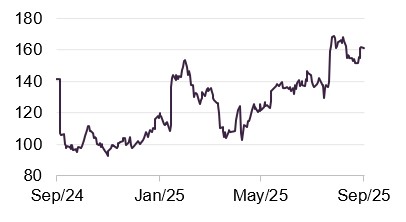
Source: Bloomberg
Nordic Semiconductor (www.nordicsemi.com) is a Norwegian fabless semiconductor company headquartered in Trondheim. It specialises in ultra-low power wireless communication technologies, particularly for the Internet of Things (IoT) market. Its product range includes system-on-chips (SoCs), system-in-packages (SiPs) and connectivity solutions.
Nordic Semiconductor has focused on short-range wireless technologies. Its Bluetooth LE solutions have been adopted in consumer electronics, healthcare devices and smart home systems. The company’s nRF51 and nRF52 product series have been used in low-power wireless markets. More recent generations indicate a strategy of expanding beyond short-range protocols into longer-range, more connected applications. The company recently acquired Memfault, a cloud service provider and former partner, to expand its offerings in cloud-based device management.
Recent share price growth may have been influenced by strong financial results. In Q2 2025, the company reported revenue of $164m, up around 28% year-on-year, and core EBITDA of around $21m, which exceeded analyst forecasts. There appears to have been renewed demand in Nordic Semiconductor’s core markets, as well as product innovation and strategic moves such as expanding into new radio-standards and longer-range connectivity.
Volex
Figure 12: Volex (GBP)
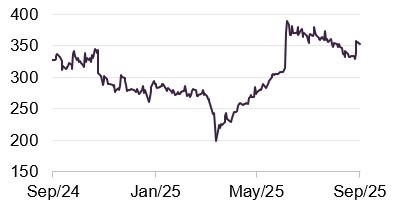
Source: Bloomberg
Volex (www.volex.com) is a UK-headquartered integrated manufacturer that produces power and data connectivity solutions for critical applications. It is structured around five main business divisions, and its operations include manufacturing ruggedised wiring harnesses, printed circuit board assemblies and other integrated systems for equipment and contract manufacturers.
As illustrated in Figure 12, during the last year Volex’s share price appears to have drifted down and then experienced a sharp drop, followed by a recovery. These moves occurred during President Trump’s “Liberation Day” tariff announcements, which were subsequently softened, and this wider context may have contributed to the share price movements.
There were also stock-specific factors, as investors appeared to react to concerns and reassurances related to Volex’s financial results and strategy. Sentiment appeared to turn negative after its half-year results in November. These results showed revenue up about 30% year-on-year, earnings per share rising by 2%, and net debt increasing to $205m. Unsolicited takeover bids for TT Electronics, a designer and manufacturer of advanced electronic components, raised concerns among investors about the possibility of overpaying and further leveraging Volex’s balance sheet. These bids were ultimately unsuccessful.
In contrast, full-year results delivered in June appeared to reassure investors. Volex reported revenue exceeding $1bn and its first underlying operating profit above $100m, with operating margins of around 10%. This appears to have contributed to a recovery in the share price.
Performance
As shown in Figures 13 and 14, HRI has outperformed the Deutsche Numis Smaller Companies plus AIM ex-Investment Companies Index (which captures the performance of the wider UK small-cap market) in NAV terms over five years. After a period of weaker performance over much of 2023 and 2024, HRI reported higher absolute numbers in 2024 and so far for 2025, which has improved the longer-term relative NAV performance versus UK small caps. HRI’s strong relative performance at the start of the COVID pandemic is no longer included in the five-year numbers, which may have reduced the relative performance compared to previous reports.
HRI’s NAV performance as measured against the Bloomberg US 2000 Technology Index appears to have been more challenged, although it was in-line on a relative basis until a divergence occurred over the past few weeks. There have been periods of both outperformance and underperformance over the past five years. Overall underperformance relative to US small-cap technology stocks may be attributed to the relative dominance of US tech companies over their international peers, both in terms of scale and performance, are discussed in comparison. As detailed on pages 9-10, HRI continues to maintain a significant allocation to the UK market, while the fund’s US allocation has steadily increased.
Figure 13: HRI’s NAV total return relative to relevant indices, over five years to 31 October 2025
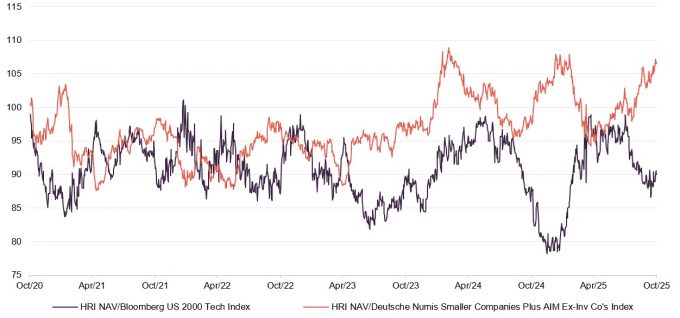
Source: Bloomberg, Marten & Co
Figure 14: Cumulative total return performance over periods ending 31 October 2025
| 1 month (%) | 3 months(%) | 6 months (%) | 1 year (%) | 3 years(%) | 5 years(%) | |
|---|---|---|---|---|---|---|
| HRI NAV | 4.2 | 7.7 | 28.2 | 21.0 | 37.3 | 44.4 |
| HRI share price | 1.6 | 1.8 | 25.2 | 20.4 | 45.3 | 45.0 |
| Deutsche Numis Smaller Cos plus AIM ex IC | 0.4 | 2.5 | 14.4 | 11.0 | 25.4 | 35.1 |
| Bloomberg US 2000 Technology | 5.0 | 17.9 | 39.2 | 19.5 | 33.8 | 61.5 |
Dividend
HRI is focused primarily on generating capital growth, and dividend income represents only a small part of returns. As a result, HRI declares a dividend only when necessary to retain investment trust status, and in practice, no dividend has been declared since 2012.
Capital structure and life
Simple capital structure
HRI has one class of ordinary share in issue. It can gear up to 50% of net assets
HRI has a simple capital structure with one class of ordinary shares in issue. Its ordinary shares have a premium main market listing on the London Stock Exchange and, as at 13 November 2025, there were 47,858,467 in issue with no shares held in treasury.
The trust is permitted to borrow up to 50% of net assets; however, it currently has no form of credit. It previously had a £25m multi-currency revolving loan facility with RBS that matured on 31 December 2019 and was not replaced. As at 30 September 2025, HRI had net liquid assets of 9.4% of its total net assets, held in a combination of cash and government bonds.
Major shareholders
Figure 17: Major shareholders as at 3 November 2025
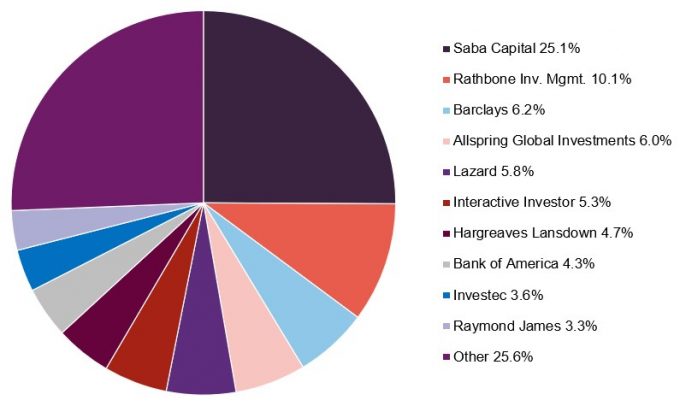
Source: Bloomberg
Saba Capital remains the largest shareholder in HRI. In addition to its direct shareholding, it has further voting rights through other financial instruments. When last reported to the market on 8 July, these amounted to a further 5.6% of the total.
Barclays and Bank of America have both increased their holdings in HRI in recent months, which may be related to Saba’s holdings through financial instruments.
Unlimited life with three-yearly continuation votes
HRI does not have a fixed life, but shareholders are offered a continuation vote every three years. The next continuation vote is scheduled for the trust’s AGM in March 2028.
Board
HRI’s board has five non-executive directors
HRI’s board is composed of five directors, all of whom are non-executive and considered to be independent of the investment manager. The current chairman, Andrew Joy, was appointed to the role in April 2023. He replaced Tom Black, who had indicated his intention to retire from HRI’s board at its AGM in April 2023.
James Will served as a non-executive director until he stepped down at the AGM in March 2025; his senior independent director responsibilities passed to existing director Henrietta Marsh.
Figure 18 shows the current composition of the board and provides information on members’ length of service and shareholdings in the company. It is board policy that all serving directors retire and offer themselves for re-election annually.
Recent share purchase and disposal activity by directors
Christopher Metcalfe has added to his personal holding of HRI shares
As is illustrated in Figure 18, with the exception of Priya Guha, all directors have personal investments in the trust. No directors have purchased HRI shares during the last 12 months. The most recent purchase was by Christopher Metcalfe, who added to his inaugural purchase of 3,000 shares by buying a further 2,200 shares on 1 August 2024. None of the directors has disposed of any shares during the last year.
Figure 18: Board members – length of service and shareholdings
| Director | Position | Date of appointment | Length of service (years) | Annual fee (GBP) 1 | Shareholding 2 | Years of fee invested3 |
|---|---|---|---|---|---|---|
| Andrew Joy | Chairman | 1 October 2022 | 3.0 | 43,950 | 6,000 | 3.4 |
| Stephanie Eastment | Chair of the audit committee | 1 December 2018 | 6.8 | 35,575 | 3,200 | 2.2 |
| Henrietta Marsh | Senior independent director | 1 September 2019 | 6.1 | 29,950 | 1,000 | 0.8 |
| Priya Guha | Director | 13 December 2023 | 1.8 | 29,950 | – | – |
| Christopher Metcalfe | Director | 24 April 2024 | 1.4 | 20,714 | 5,200 | 6.2 |
| Average (service length, annual fee, shareholding, years of fee invested) | 3.8 | 32,028 | 3,080 | 2.5 | ||
Board diversity
Two out of the three most-senior board positions is held by a woman
A majority of the board – three out of five members – is female. Two of the three most senior positions (chair of the audit committee and senior independent director) are held by women, and one (chairman) is held by a man.
At present, the board is composed of four individuals who are classified as White British or other White (including minority-White groups) and one that is minority ethnic. The board states that appointments are made on merit. The board also states that it will ensure a diverse group of candidates is considered, and that these will be evaluated against objective criteria with regard to the benefits of diversity, including gender, social and ethnic background, and personal strengths, experience, and knowledge.
Andrew Joy (chairman)
Andrew is highly regarded for his extensive knowledge of the financial sector and of the high-growth part of the smaller company sector. He was one of the founding partners of Cinven, a leading private equity firm investing in Europe and US, and has been chairman or director of numerous growth companies over the past 30 years. He is also a senior advisor of Stonehage Fleming, chairman of the investment committee of FPE Capital, and a trustee of several charities. He was previously chairman of The Biotech Growth Trust Plc.
Stephanie Eastment (chair of the audit committee)
Stephanie is a chartered accountant and company secretary with over 30 years’ experience in the financial services industry. She has considerable experience in the investment trust sector and is a member of the AIC’s Technical Committee. Stephanie qualified with KPMG and held various accounting and compliance roles at Wardley and UBS before joining Invesco Asset Management in 1996 as Manager, Investment Trust Accounts. When she left Invesco in July 2018, she was Head of Specialist Funds Company Secretariat and Accounts. Stephanie is the non-executive senior independent director of Murray Income Trust Plc, a non-executive director and audit chairman of Impax Environmental Markets plc and Alternative Income REIT plc, and a non-executive director of RBS Collective Investment Funds Limited.
Henrietta Marsh (senior independent director)
Henrietta has a background in fund management, having worked in UK small-cap and private equity investment over several decades. From 2005 until 2011, she was AIM fund manager at Living Bridge Equity Partners and, prior to that, she spent 14 years at 3i in several roles, including as fund manager of 3i Smaller Quoted Companies Trust Plc (1997–2002). Henrietta spent her early career with Morgan Stanley and Shell. More recently she has pursued a non-executive career, having served on the boards of discoverIE plc, Alternative Networks plc, Electric Word plc and Gamma Communications plc (AIM-listed) where she was the senior independent director.
Priya Guha MBE (director)
Priya has significant knowledge of the global technology sector and experience in both public and private sectors. She currently has a portfolio of roles across the global and UK technology and innovation landscape, including as a non-executive director at UK Research & Innovation and Digital Catapult, a member of the Investment Governance Board at Future Planet Capital, a UK VC Fund and an advisor to various start-up companies including Gallos Technologies. She is also a non-executive director at Reach PLC and chairs its sustainability committee
Christopher Metcalfe (director)
Christopher has considerable investment management experience, having worked previously at Newton Investment Management (2006–2017), Schroder Investment Management (1995–2006) and Henderson Administration Group plc (1985–1994). He is currently chairman of the Martin Currie Global Portfolio Trust, senior independent non-executive director at JP Morgan US Smaller Companies Investment Trust Plc, and a non-executive director of Columbia Threadneedle UK Capital and Income Investment Trust Plc. He was previously a non-executive director of abrdn Smaller Companies Income Trust Plc until its merger with Shires Income in December 2023.
Management team
Katie Potts
Katie is the managing director and also the lead fund manager for HIML. She established HIML in December 1993 to manage HRI, which was launched in February 1994. Katie read Engineering Science on a GKN Group scholarship at Lady Margaret Hall, University of Oxford. She worked for five years in investment management at Baring Investment Management Limited before joining S.G. Warburg Securities’s UK electronics research team in 1988. The team was consistently voted top team in the Extel survey of analysts in the sector, and she was voted top analyst by finance directors of electronics companies canvassed by The Treasurer magazine. In addition, Katie had responsibility within S.G. Warburg’s UK research department for commenting on accounting issues.
Katie is supported in managing the funds by a team of nine other investment professionals in the UK, and one at HRI’s US affiliate.
Fraser Elms
Fraser Elms joined HIML in May 2000. He is the deputy manager of HRI and has lead responsibility for managing HIML’s Asian portfolios. Prior to joining HIML, Fraser was a technology analyst with Dresdner Kleinwort Benson, where he covered the European technology sector. Before this he worked at Prudential for three years as member of a team of three UK unit trust fund managers that managed £5bn in equities, with Fraser having lead responsibility for three funds collectively worth £400m. He graduated from Lancaster University with a degree in Economics and initially joined Prudential as a product manager for their unit trusts, before completing an MSc in Investment Analysis at the University of Stirling and re-joining Prudential in an investment role. Fraser covers the semiconductor sector.
Taymour Ezzat
Taymour joined HIML in November 2004. He has responsibility for the European portfolio and analytical responsibility for the media sector. Previously he spent a year appraising several venture capital opportunities for E.D. Capital Partners. Prior to that, Taymour had spent six years at Northcliffe Newspapers, the regional newspapers division of Daily Mail & General Trust (DMGT), latterly as Finance Director of its electronics publishing arm, after working for Reuters in London and Eastern Europe for four years. He qualified as an accountant with Price Waterhouse and studied Economic History at the London School of Economics and Political Science. He was also a portfolio manager on the venture funds (which were wound up in H1 2023) sitting on the venture committee and taking lead responsibility for a number of the investments in the venture portfolios.
Hao Luo
Hao joined HIML in 2004 and works with Fraser Elms on managing the Far East portfolios. He also has analytical responsibility for the manufacturing sector globally. Hao obtained a BA in Economics from Hunan University in China and a Masters degree in Finance from Manchester University, and worked for J&A Securities in Shanghai from 2000-2002. He is a CFA charterholder.
Peter Jenkin
Peter joined HIML as an analyst in 2015. He covers the software sector and contributes to the overall investment selection. Previously, Peter worked jointly on the European portfolio, but now has responsibility for HRI’s North American portfolio. Before joining HIML, he studied Construction Engineering Management at Loughborough University.
Danny Malach
Danny joined HIML in 2016. He was the lead dealer for the fund and in 2022 began working as an analyst on the UK team. He has analytical responsibility for computer gaming and IT services companies globally. Danny has a CFA qualification.
Fati Naraghi
Fati joined HIML towards the end of 2019 to focus on the Herald Worldwide Technology Fund and to cover some of the larger technology companies. Prior to joining HIML, she spent 20 years at Newton Investment Management, where she was responsible for the global tech sector. Fati has a PhD in Communications Systems and is qualified as an AWS Cloud Practitioner.
Matthew Lloyd
Matthew joined HIML in 2019 as a portfolio assistant and analyst. He has analytical responsibility for Alternative Energy and began working with the Asia team in 2020. Matthew has a MEng in Mechanical Engineering.
James de Jonge
James joined HIML in 2022 as an analyst on the UK portfolio, and was subsequently given analytical responsibility for the defence and medical technology sectors worldwide. Before joining the team at Herald, he managed the audits of FTSE-listed commodities trading and renewables infrastructure clients at Deloitte. James is a qualified accountant and a CFA Level 3 candidate.
Bob Johnston
Bob was recruited in 2016 to establish a US office for HIML. He has more than 20 years’ experience in the technology sector on the sell-side, and has worked with the HIML team for roughly 15 years. Most recently, Bob was with technology specialist Pacific Crest. He previously also worked for Hambrecht & Quist and SoundView Technology Group. Bob has taken on responsibility for telecommunications, networking and security analysis. US companies do not come to the UK as they used to, and Herald feels it necessary to have a US presence to enable maintenance of frequent contact with companies.
Fund profile
More information can be found at the trust’s website: www.heralduk.com.
Established in 1994, HRI invests globally in small technology, communications, and multimedia companies with the stated aim of achieving capital growth. It is the only listed fund of its type. The trust invests globally and continues to have a significant bias towards the UK, although this has been reduced in recent years. HRI’s allocation to the UK distinguishes it from other global technology funds, which tend to be more heavily biased towards the US.
New investments in the fund will typically have a market capitalisation of $5bn or less but are generally smaller when the first investment is made. If successful, these may grow to be a multiple of their original valuation. This type of investing is longer-term in nature and so the trust’s portfolio tends to have low turnover. Reflecting the risks associated with this type of investing, and the liquidity constraints of having a small-cap investment remit, the trust maintains a diverse portfolio of investments (typically in excess of 250) to help mitigate this risk.
Experience is important in markets such as these
Katie Potts has managed HRI since its launch. Her track record suggests that experience may be important in markets such as these
In addition to the points outlined in this note, Katie and her team have significant experience. Katie previously worked as a technology analyst at SG Warburg (later UBS) before launching the fund. Katie is supported by nine professionals, and this team now manages a large proportion of HRI’s portfolio.
Members of the Herald team include Fraser Elms, HRI’s deputy manager, who joined Herald Investment Management in 2000 and covers Herald’s Asian portfolios and the semiconductor sector; Taymour Ezzat, who joined in 2004 and covers Herald’s European investments and media; Hao Luo, who also joined in 2004 and helps cover Asia and manufacturing sectors; and Peter Jenkin, who joined Herald in 2015 and covers Herald’s North American and software investments.
Katie owns a substantial stake in the company and a significant minority stake in the management company, which may provide her with motivation to seek the success of the fund.
HRI’s closed-ended structure can be advantageous during market selloffs
The HRI team has experienced several downturns and has benefitted from its ability to select companies that appear capable of operating under difficult conditions. HRI’s closed-ended structure has also been used in this context. Whilst open-ended funds are often required to sell holdings, HRI can use gearing and may acquire stocks at lower prices, though it has been maintaining a net cash allocation more recently.
HRI’s size and focus on smaller companies, and the depth of expertise within the management team, mean that it provides capital to listed technology companies seeking expansion capital. This may be particularly relevant in a downturn and has offered HRI opportunities to generate alpha when others may not have been able to.
HRI offers a liquid subcontract for investors seeking access to this part of the market. The manager states that an investment in HRI complements an investment in one of the large-cap technology funds.
Previous publications
Readers interested in further information about HRI may wish to read our previous notes. You can read the notes by clicking on them in Figure 21 or by visiting our website.
| Title | Note type | Date published |
|---|---|---|
| Invest in the future | Initiation | 16 August 2016 |
| Tech bids demonstrate value | Update | 20 December 2016 |
| Backing growing businesses | Update | 11 July 2017 |
| Who wants to be a billionaire? | Annual overview | 7 December 2017 |
| From small acorns…. | Update | 12 June 2018 |
| Shifting sentiment | Annual overview | 12 February 2019 |
| “Profits are only profits when they are realised” | Update | 8 October 2019 |
| Change is a coming | Annual overview | 4 April 2020 |
| Hot chips | Update | 5 November 2020 |
| The future is bright | Annual overview | 2 February 2022 |
| Efficiency Savings | Annual overview | 11 January 2023 |
| Patience and power | Update | 13 November 2023 |
| Heralding in the age of AI | Annual overview | 25 June 2024 |
IMPORTANT INFORMATION
Marten & Co (which is authorised and regulated by the Financial Conduct Authority) was paid to produce this note on Herald Investment Trust Plc.
This note is for information purposes only and is not intended to encourage the reader to deal in the security or securities mentioned within it. Marten & Co is not authorised to give advice to retail clients. The research does not have regard to the specific investment objectives financial situation and needs of any specific person who may receive it.
The analysts who prepared this note are not constrained from dealing ahead of it but, in practice, and in accordance with our internal code of good conduct, will refrain from doing so for the period from which they first obtained the information necessary to prepare the note until one month after the note’s publication. Nevertheless, they may have an interest in any of the securities mentioned within this note.
This note has been compiled from publicly available information. This note is not directed at any person in any jurisdiction where (by reason of that person’s nationality, residence or otherwise) the publication or availability of this note is prohibited.
Accuracy of Content: Whilst Marten & Co uses reasonable efforts to obtain information from sources which we believe to be reliable and to ensure that the information in this note is up to date and accurate, we make no representation or warranty that the information contained in this note is accurate, reliable or complete. The information contained in this note is provided by Marten & Co for personal use and information purposes generally. You are solely liable for any use you may make of this information. The information is inherently subject to change without notice and may become outdated. You, therefore, should verify any information obtained from this note before you use it.
No Advice: Nothing contained in this note constitutes or should be construed to constitute investment, legal, tax or other advice.
No Representation or Warranty: No representation, warranty or guarantee of any kind, express or implied is given by Marten & Co in respect of any information contained on this note.
Exclusion of Liability: To the fullest extent allowed by law, Marten & Co shall not be liable for any direct or indirect losses, damages, costs or expenses incurred or suffered by you arising out or in connection with the access to, use of or reliance on any information contained on this note. In no circumstance shall Marten & Co and its employees have any liability for consequential or special damages.
Governing Law and Jurisdiction: These terms and conditions and all matters connected with them, are governed by the laws of England and Wales and shall be subject to the exclusive jurisdiction of the English courts. If you access this note from outside the UK, you are responsible for ensuring compliance with any local laws relating to access.
No information contained in this note shall form the basis of, or be relied upon in connection with, any offer or commitment whatsoever in any jurisdiction.
Investment Performance Information: Please remember that past performance is not necessarily a guide to the future and that the value of shares and the income from them can go down as well as up. Exchange rates may also cause the value of underlying overseas investments to go down as well as up. Marten & Co may write on companies that use gearing in a number of forms that can increase volatility and, in some cases, to a complete loss of an investment.
